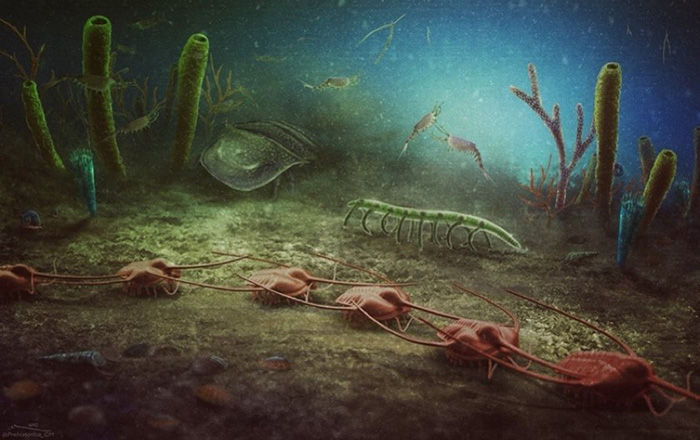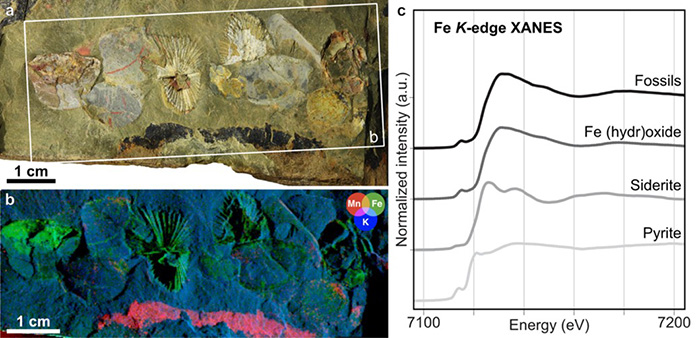A new fossil bed has been uncovered in the French department of Hérault through the perseverance of two ardent amateur palaeontologists. The couple’s discoveries were studied by scientists from teams based in Switzerland, the Czech Republic, the USA and France, including the PUMA beamline.
In the outskirts of Cabrières, near Pézenas, marine sedimentary rocks dating back 470 million years-old have yielded over 400 fossils that attest to the closest ecosystem to the Ordovician south pole hitherto discovered. Among the most bountiful and diverse fossil beds from that geologic period, the Cabrières site stands out for its remarkable degree of preservation, which enabled the rare discovery of soft-bodied organisms. The latter include a wide variety of algae and sponges, contributing to a better understanding of the pivotal role they played in their ecosystem.

Figure 1: Artistic reconstruction of the Cabrières Biota © Christian McCall
These findings challenge previous thinking that posited a decrease in biodiversity or even an extinction between the Cambrian and Ordovician Periods, approximately 485 million years ago. The high level of biodiversity observed does, however, confirm the hypothesis of species’ migration toward the Ordovician southern hemisphere, seeking refuge from the excessive temperatures of the tropical zones.
Some of these fossils made the journey to SOLEIL and the PUMA beamline to determine their chemical composition, and thus decipher the processes that led to their exceptional preservation.
Using X-ray fluorescence major-to-trace elemental mapping and X-ray absorption spectroscopy (XANES), paleontologists were able to establish that the fossils are essentially made up of a layer of Fe(III) oxide/hydroxide crystals, varying in thickness and containing traces of metals. The distribution of other elements, notably manganese and arsenic, strongly suggests that iron oxide (hydr)oxides do not represent the original mode of preservation of these fossils, but rather result from more recent alteration processes, as demonstrated for other contemporary deposits. These observations enable paleontologists to identify any biases that may have affected the completeness of the fauna and flora discovered, as well as enabling finer comparisons with other sites.

Figure 2:Analyses of an assemblage of organisms discovered at the Cabrières site at the PUMA beamline.
(a) Photograph of this assemblage, consisting of two brachiopods (center), five bivalve arthropod carapaces (left and bottom right) and a trilobite head (right).
(b) Distributions of manganese (red), iron (green) and potassium (blue) obtained by X-ray fluorescence mapping.
(c) XANES X-ray absorption spectroscopy reveals that iron is present in the fossils as iron oxides/hydroxides.
The initial study of the site, whose findings are published in Nature Ecology & Evolution, inaugurates a research program that is to span several years and include large-scale excavations followed by in-depth analyses of fossils, using innovative imaging techniques. The aim is to detail the fossilized organisms’ internal and external anatomies, taxonomic relationships, and modes of life and fossilization.
